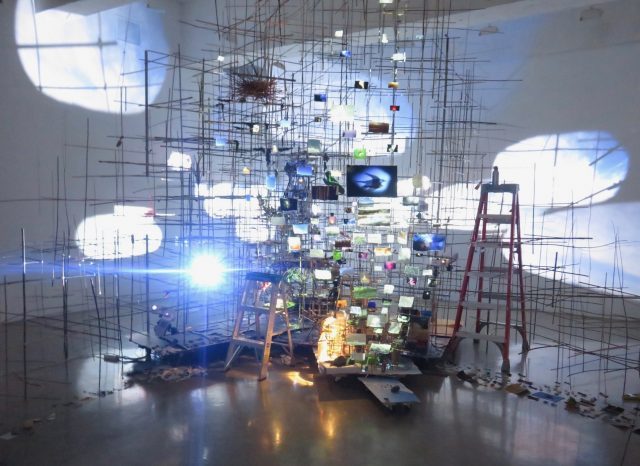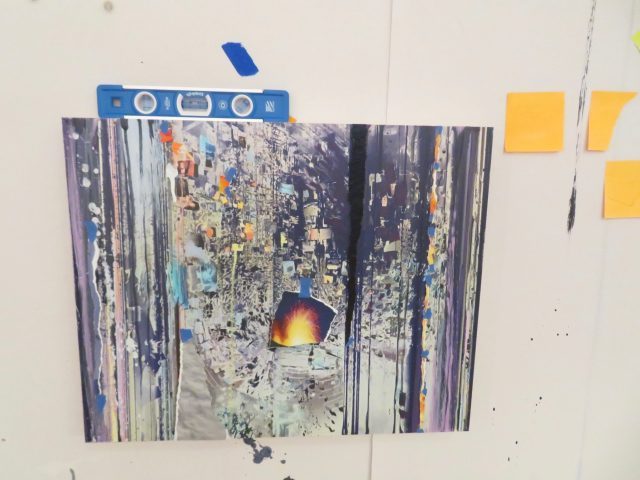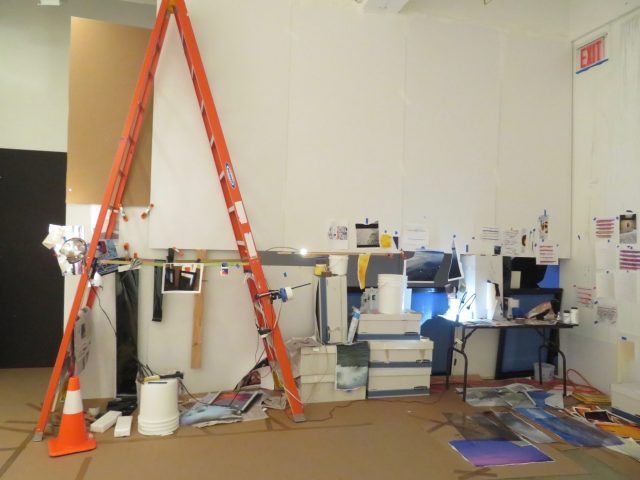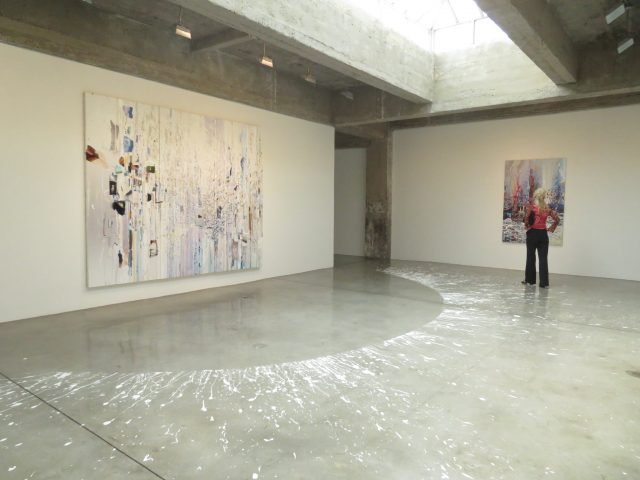
Sarah Sze’s Crescent (Timekeeper) immerses visitors at Tanya Bonakdar (photo by twi-ny/mdr)
Tanya Bonakdar Gallery
521 West 21st St. between Tenth & Eleventh Aves.
Through October 19, free, 10:00 am – 6:00 pm
212-414-4144
www.tanyabonakdargallery.com
www.sarahsze.com
sarah sze slideshow
Sarah Sze has long been creating intricate, fragile ecosystems that feel like a complex construction made of giant toothpicks (and just about anything else she can find) that could come tumbling down with a mere touch. These installations have grown more detailed over time, incorporating high-tech electronic elements while expanding the breadth of its range. Her latest immersive exhibition at Tanya Bonakdar in Chelsea begins outside the gallery and continues in the hallways, large main space, back room, and upstairs, on the walls and the floors and the ceilings. There’s something everywhere, transforming parts of the gallery into her studio, revealing her extraordinary process. Originally a painter who now considers herself a sculptor, the Boston-born, New York-based artist centers the show with Crescent (Timekeeper), an exquisite work consisting of dozens of objects, from ladders, boxes, and rocks to plants, lamps, and bottles. Videos are projected onto torn pieces of paper, including a flying eagle, prowling wolves, the swirling ocean, and a burning fire, enhanced by sound as well, each open in its own internet browser, leaving it up to the viewer to make a narrative.

Sarah Sze reveals some of her methodology in Tanya Bonakdar back room (photo by twi-ny/mdr)
There are no barriers to prevent you from getting too close to the delicate piece; there’s a guard situated on the other side of the room, but Sze trusts us to not wreak havoc. She also shows us what she’s doing; the hallway is filled with her notes, some of the materials she uses (tape, paint, push pins, photographs, videos), while behind Crescent (Timekeeper) is a stack of slowly turning projectors, casting light and shadows everywhere. The back room is a cluttered studio setting with boxes, painted canvases with images stuck on, water bottles, paper towels, and other general detritus — the process has become the work.

A studio space offers viewers a look at Sarah Sze’s creative process (photo by twi-ny/mdr)
Upstairs is a room of four gorgeous painting collages, streaks of white paint on the floor forming a half-moon around one, as if beaming in through the skylight. Be sure to get close to the works to experience their startling depth. In the smaller, dark room, Sze lays bare her process of projecting tiny images onto a wall, revealing how she first designs them on a computer, then projects them through a sculptural form and onto the far wall. It’s utterly ingenious and wholly captivating.
Sze’s works are particularly suited to our image-saturated urban life, and especially here in New York City: Her Triple Point (Pendulum) is part of MoMA’s “Surrounds: 11 Installations” exhibition opening next week, her Blueprint for a Landscape can be seen all over the 96th St. stop on the Second Ave. subway, and her birdhouse Still Life with Landscape (Model for a Habitat) was on the High Line in 2012. And in 2006, her partially submersive Corner Plot welcomed people to the Scholars’ Gate entrance to Central Park.

Paint forms a kind of floor sculpture in Sarah Sze show in Chelsea (photo by twi-ny/mdr)
In her 2018 essay “The Tattered Ruins of the Map: On Sarah Sze’s Centrifuge,” Sze’s friend, award-winning writer Zadie Smith, writes, “Like so much of Sarah Sze’s work, Centrifuge is a complex constellation of elements, in which all constituents present themselves simultaneously. . . . After the rupture, after the apocalypse, amid the ruin of cables and wires, someone might ask: what was the purpose of all of those images within and through which we lived?” This is true of her current Chelsea show, as Sze merges disparate components and artistic disciplines, both analog and digital, to forge a deep dive into the nature of time, space, and memory in a chaotic age.